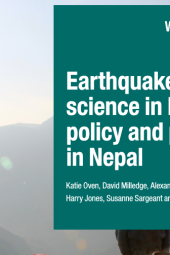Earthquake science in DRR Policy and Practice in Nepal
Summary
This working paper summarizes current and potential uses of earthquake science in disaster risk reduction and resilience-building activities in Nepal. It is written for anyone with an interest in earthquake DRR in Nepal, in particular scientists who generate earthquake science and practitioners and policy-makers who could use it. The study has been undertaken as part of the Earthquakes without Frontiers (EwF) project, funded by the UK Natural Environment Research Council and Economic and Social Research Council. The project aims to support governments, non-governmental organizations, and communities to build resilience to earthquakes and secondary hazards along the Alpine-Himalayan belt. It is focused on four case study countries: Nepal, the neighboring Indian state of Bihar, Kazakhstan, and China. Nepal is a geologically active country with a long history of destructive earthquakes – most recently in the 2015 Gorkha earthquake sequence. There have been substantial advances in the scientific understanding of earthquake hazards in Nepal, but it is not clear how that understanding has informed, or could inform, national and international investment in earthquake DRR activities, and to what effect. This paper aims to understand the role that earthquake science plays in DRR policy and practice in Nepal by seeking answers to questions regarding disasters and scientific knowledge.
Categories:
Report
Publisher:
Earthquake Without Frontiers
Published Year:
2016
